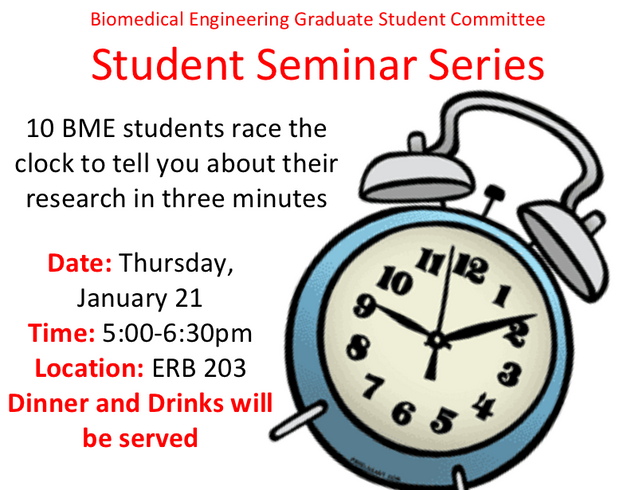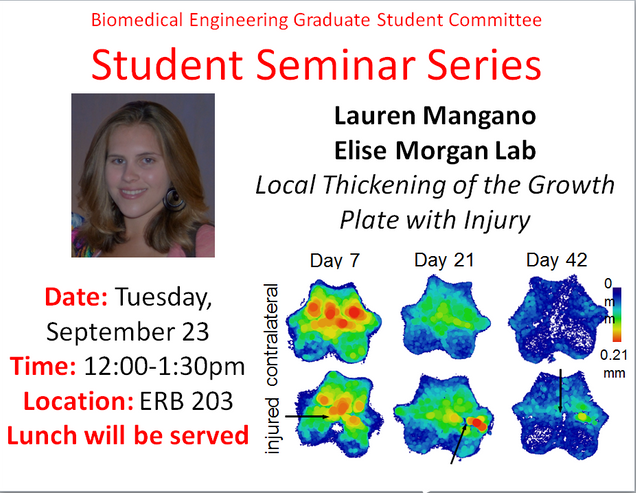Student Seminar
The BME Student Seminar launched in the summer of 2015 with the goal of creating a laid-back environment where BME graduate students can share their research and get feedback from their peers. The Student Seminar runs monthly and is a great venue to practice for a conference or prospectus presentation, work on your presentation skills, or simply bounce ideas off of your peers.
If you are interested in presenting, please email bmegsc@bu.edu!
To view past speakers, check out the archive here.
Spring 2020 Presenters
| Date | Speaker | Talk Title |
|---|---|---|
| 02/21/2020 | Jack Giblin (BOAS Lab) | Quantifying hypoxic effects of capillary flow disruptions |
| TBD | TBD | TBD |
| TBD | TBD | TBD |
Fall 2019 Presenters
| Date | Speaker | Talk Title |
|---|---|---|
| 10/25/2019 | Matti Groll (Stepp Lab) | How does the target selection method affect accelerometer-based AAC devices? |
| 10/25/2019 | Michael Sheets (Dunlop Lab) | Light-inducible recombinases for bacterial optogenetics |
| 11/22/2019 | ~~ | ~~ |
| 12/12/2019 | ~~ | ~~ |
Talks will be held from 12pm – 1pm in ERB 203 with lunch provided.
Student Seminar Series with Raeef Istfan
August Grad Student Seminar
Please join us on Tuesday, August 23 at 12:00pm in ERB 203 for our next BME Student Seminar. Our goal is to create a laid-back environment where BME grad students can share their research and get feedback from their peers. David Bernstein will be presenting "Studying Microbial Interactions to Gain an Ecological Perspective on Microbial Communities." Come by to learn about his work, provide feedback, and (of course) enjoy lunch with your peers!
When: Tuesday, August 23, 12:00-1:00pm
Where: ERB 203
David Bernstein, Segre Lab
Studying Microbial Interactions to Gain an Ecological Perspective on Microbial Communities
Microbial communities are ubiquitous in nature and have broad influences on processes ranging from biogeochemical cycles to human health. Metagenomic sequencing of such communities has generated vast amounts of data on the various microbes present in different habitats. This information has inspired an ecological perspective on microbiology which has led to significant breakthroughs in science and medicine such as cultivating previously uncultivated organisms and curing recurrent infections via fecal matter transplants. Despite these successes, the mechanistic details behind them are relatively obscure. Engineering microbial communities will require detailed mechanistic understanding of the interactions underlying their ecology. We propose several approaches to this end: 1) a computational framework to predict microbial interactions based on metabolism, 2) an experimental device to facilitate the observation of microbial interactions, and 3) an investigation of a global parameter driving microbial interaction. Through these aims we hope to further understand the interactions underlying microbial community structure in order to help transition the field from a descriptive to a predictive science.
If you are interested in presenting at a later seminar, please fill out this quick form!
BME Student Seminar, Wednesday, June 8, 12pm
Please join us on Wednesday, June 8 at 12:00pm in ERB 203 for our next BME Student Seminar. Our goal is to create a laid-back environment where BME grad students can share their research and get feedback from their peers. Meghan Thommes will be presenting "Controlling Microbial Growth Dynamics through Environmental Manipulation." Come by to learn about her work, provide feedback, and (of course) enjoy lunch with your peers!
February Grad Student Seminar

November Grad Student Seminar
October Student Seminar
Please join us Thursday, October 15 at noon in ERB 203 for the second BME Student Seminar of the fall semester. Our goal is to create a laid-back environment where BME grad students can share their research and get feedback from their peers. Samer Bou Jawde will be presenting "A Lumped Parameter Model of Fiber Recruitment in the Extracellular Matrix." Come by to learn about his work, provide feedback, and (of course) enjoy lunch with your peers.
When: Thursday, October 15, 12:00-1:00pm
Where: ERB 203
Fall 2015 Schedule:
Tuesday, November 3: Nitinun Bell Varongchayakul, Amit Mellar Lab
December TBA: Sign up!
Samer Bou Jawde, Bela Suki Lab
A Lumped Parameter Model of Fiber Recruitment in the Extracellular Matrix
The biomechanical properties of biological tissues play important roles in the normal functioning of tissues and organs. These biomechanical properties at the macroscopic scale are characterized by the stress-strain relation which is invariably nonlinear as is the case for fibers embedded in the extracellular matrix (ECM). Previous computational models have attributed the nonlinear behavior to the recruitment of collagen fibers. While such models can simulate microscopic alignment of fibers within the ECM, to our knowledge, their complexity does not allow fitting these models to estimate the microscale properties of the tissue. To this end, a lumped parameter analytical model of tissue stress-strain behavior has been developed that incorporates the alignment of linearly elastic fibers in the elastic ECM. Using simulations, it is demonstrated that this model captures the observed nonlinearity of the stress-strain curve. These results can shed light on the importance and contribution of various microscale properties of the fibers and ECM to macroscale nonlinearity. The simplicity of the approach allows us to fit the model to data and hence extract microscale tissue parameters from macroscale experimental data.
September Grad Student Seminar
Please join us on September 22 at noon in ERB 203 for the first BME Student Seminar of the fall semester. Our goal is to create a laid-back environment where BME grad students can share their research and get feedback from their peers. Lauren Mangano will present "Local Thickening of the Growth Plate with Injury." Come by to learn about her work, provide feedback, and (of course) enjoy lunch with your peers.
When: Tuesday, September 22, 12:00-1:30pm
Where: ERB 203
RSVP so we can order enough food
Presenter: Lauren Mangano, Elise Morgan Lab
Local Thickening of the Growth Plate with Injury
Injury to the growth plate is associated with premature growth arrest and growth disturbance, including shortening of the injured limb and angular deformities. Developing successful, less invasive treatments for growth plate injury has been impeded by incomplete understanding of the features of the injury response that cause these growth problems. Radiographic evidence indicates that the growth disturbances are associated with formation of bony bridges at the injury site; however, conflicting reports exists as to how these bony bridges form. Histological evidence has revealed disorganized chondrocyte columns and increased growth plate thickness in the region of the growth plate adjacent to the injury site, suggesting that local changes in cellular activity is may contribute to angular deformities. Using contrast-enhanced micro-computed tomography (CECT) for cartilage imaging, local changes in the cartilaginous and osseous tissues in the healing growth plate can be examined robustly with quantitive, three-dimensional measurement.
The goal of this study was to quantify spatial changes in the morphology and composition of the growth plate that occur in response to injury. The specific objectives were: 1) to quantify local changes in growth plate thickness and CECT attenuation (indicative of glycosaminonglycan (GAG) content (cite)) adjacent to the injury site; 2) to quantify the amount of bone formed within the growth plate following injury.
Fall 2015 Schedule:
Thursday, October 15: Samer Bou Jawde, Bela Suki Lab
Tuesday, November 3: Nitinun Bell Varongchayakul, Amit Mellar Lab
December TBA: Sign up!



